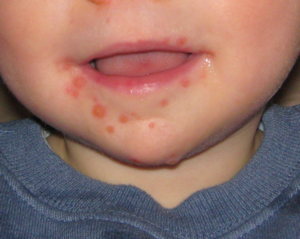Hand, foot and mouth disease
| Hand, foot and mouth disease | |
|---|---|
 |
|
| Typical lesions around the mouth of an 11-month-old boy | |
| Specialty | Infectious disease |
| Symptoms | Fever, flat discolored spots or bumps that may blister |
| Complications | Temporary loss of nails, viral meningitis |
| Usual onset | 3–6 days post exposure |
| Causes | Coxsackievirus A16, Enterovirus 71 |
| Diagnostic method | Based on symptoms, viral culture |
| Prevention | Handwashing |
| Treatment | Supportive care |
| Medication | Pain medication such as ibuprofen |
| Frequency | As outbreaks |
| Classification | |
|---|---|
| External resources |
Hand, foot and mouth disease (HFMD) is a common infection caused by a group of viruses. It typically begins with a fever and feeling generally unwell. This is followed a day or two later by flat discolored spots or bumps that may blister, on the hands, feet, and mouth, and occasionally buttocks and groin. Signs and symptoms normally appear 3–6 days after exposure to the virus. The rash generally goes away on its own in about a week. Fingernail and toenail loss may occur a few weeks later and these then regrow.
The viruses that cause HFMD are spread through close personal contact, through the air from coughing, and the feces of an infected person. Contaminated objects can also spread the disease.Coxsackievirus A16 is the most common cause and Enterovirus 71 is the second-most common cause. Other strains of coxsackievirus and enterovirus can also be responsible. Some people may carry and pass on the virus despite having no symptoms of disease. Other animals are not involved. Diagnosis can often be made based on symptoms. Occasionally throat or stool sample may be tested for the virus.
Handwashing may prevent spread and those infected should not go to work, daycare, or school. No antiviral medication or vaccine is available, but development efforts are underway. Most cases require no specific treatment. Simple pain medication such as ibuprofen or numbing mouth gel may be used. Occasionally intravenous fluids are given to children who are unable to drink enough. Rarely viral meningitis or encephalitis may complicate the disease.
HFMD occurs in all areas of the world. It often occurs in small outbreaks in nursery schools or kindergartens. Large outbreaks have been occurring in Asia since 1997. It usually occurs during the spring, summer, and fall months. Typically it occurs in children less than five years old, but can occasionally occur in adults. HFMD should not be confused with foot-and-mouth disease (also known as hoof-and-mouth disease) which mostly affects livestock.
...
Wikipedia
